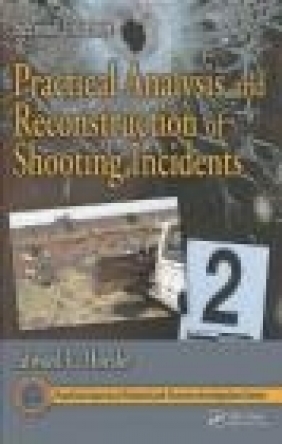Practical Analysis and Reconstruction of Shooting Incidents
Edward Hueske
Practical Analysis and Reconstruction of Shooting Incidents
Edward Hueske
- Producent: Productivity Press Inc
- Rok produkcji: 2016
- ISBN: 9781498707664
- Ilość stron: 506
- Oprawa: Twarda
Niedostępna
Opis: Practical Analysis and Reconstruction of Shooting Incidents - Edward Hueske
Practical Analysis and Reconstruction of Shooting Incidents, Second Edition presents a holistic approach to shooting incident analysis and reconstruction, covering the entire spectrum of related sub-disciplines of forensic science. The book reviews basic firearm design and function, ammunition components, and terminology, explaining what constitutes pertinent evidence and appropriate results relative to autopsies, forensic laboratory analysis, and reenactments. The second edition features numerous additions including: * Four new chapters * Complete and extensive updates to all 16 original chapters * Three case studies contributed by renowned professionals in the field * New and revised exercises at the ends of chapters, with answers provided * An expanded glossary of terminology * Nearly 340 figures and illustrations, with several in full color * New and updated references and suggested readings * Appendices containing relevant terminology, checklists, and other resources The book details the mathematics of shooting reconstruction in clear, precise language that allows readers-both those with and without extensive science backgrounds-to apply a logical thought process to the evaluation of shooting scene evidence in order to establish the probable related events to the shooting incident. This new edition provides up-to-date information for field investigators to recognize, preserve, document, and interpret the physical evidence typically found after shooting incidents. In addition to the hundreds of illustrations, the book uses both case studies and step-by-step outlines to clearly describe the required analytical processes involved in reconstructing and interpreting shooting incident scenes.Terminology: Its Use and Abuse-"The Devil Is in the Details" Ammunition Components Rule #1: CALL IT WHAT IT IS Firearms Other Misused Terms Suggested Reading Shooting Reconstruction Myth Busters Bullets and Newton's Third Law Bullets and Intermediary Targets Bullet and Shot Pellet Ricochets Shotgun Wads, Cups, and Wrappers Gunshot Residues Cartridge Case Ejection Blood Back Spatter from Gunshots Suggested Reading Reference Theory and Practice of Shooting Reconstruction Shooting Reconstruction and the Scientific Method On-Scene Evidence Evaluation/Documentation Off-Scene Evaluation and Documentation Goal of Shooting Reconstruction Limitations of Shooting Reconstructions Reenactment in Shooting Reconstructions Other Body Indicators Other Scene Indicators Suggested Reading Reference Mathematics of Shooting Reconstruction Trigonometry, Geometry, and Shooting Incident Analysis Calculation of Impact Angles Other Calculations References Firearms and Ammunition Components Firearms Categories and Nomenclature Special Notes Concerning Firearms Ammunition Components Scene Documentation of Weapons References Shooting Reconstruction Equipment and Its Use Documentation of Bullet Holes at Shooting Scenes Trajectory Rods and Their Use at Shooting Scenes Other Equipment Required Laser Measuring Devices Total Data Stations 3-D Laser Scanners Chronographs Specialized Fixtures for Shooting Reconstruction Camera Equipment for Shooting Reconstruction References Smart Phone/Pad Apps for Shooting Reconstruction Plumb Bob App Compass App Angle Gauge App Scientific Calculator App Level App Global Positioning System App Measuring Apps Flashlight App Other Useful Specialty Apps Other Visual Aids Cartridge Case Ejection Pattern Testing for Semiautomatics Testing Considerations Methodology Interpretation of Results References and Further Reading Shotgun Pattern Testing and Evidence Evaluation Approximating Muzzle-to-Target Distance Angle of Impact Estimation Test Firing Graphical Analysis Shot Shell Buffer and Distance Estimation Reporting of Results References Examination/Testing of Weapons and Ammunition Components Trace Evidence Examination Function Testing Accuracy Determination Rate of Fire Determination Suggested Reading Gunshot Residue Testing GSR Sources Persistence of Primer Residue Primer Residues and Shooter Determination Muzzle-to-Target Distance Approximation Testing-Inanimate Objects Collection of GSR from Fixed Inanimate Objects Muzzle-to-Target Distance Approximation Testing-Human Tissue "Paraffin" Test Determination of Time Since Discharge Case Study Suggested Reading Bullet Hole and Wound Characteristics Bullet Holes in Clothing and Underlying Tissue Reconciling Bullet Holes in Clothing with Underlying Wounds Bullet Holes in Glass and Glass Injuries Bullet Holes in Tires and Other Elastic Materials Documentation Case Study Suggested Reading Bullet Ricochet Phenomena Ricochet Terminology Conditions Conducive to Ricochets Directionality Based on Point of Impact Other Indicators of Directionality Ricochet Crease Profiles Direction of Twist Determination from a Ricochet Mark Establishing Critical Angles Establishing Ricochet Angles Establishing Deflection Angles Establishing Shooter Position Documentation Evidence That a Ricochet Has Occurred Case Study Suggested Reading Bloodstains and Blood Spatter at Shooting Scenes Blood Characteristics and Drop Formation Blood Spatter Associated with Firearms Injuries Blood on/in Weapons Blood on the Hands of the Shooter Blood on Objects at the Shooting Scene Nongunshot Dynamics That Can Mimic High-Velocity Impact Blood Spatter Blood and Its Use in Time Line Development Case Study Locating Latent Bloodstains Suggested Reading Officer-Involved Shootings General Considerations Unintentional Discharge of Weapons Suicide by Cop Case Studies Why Is the Suspect Shot in the Back? Suggested Reading Case Analysis General Considerations Shot Accounting Recognizing Staged/Misrepresented Crime Scenes Off-Scene Analysis of Crime Scene Data Homicide versus Suicide Issues Participant Information to Obtain Shots Fired into Vehicles General Case Analysis Examples Suggested Reading References Ballistics Internal Ballistics External Ballistics Terminal Ballistics Sound Suppressors Case Studies Suggested Reading Firearm/Ammunition Reference Collections, Databases, and Software Weapons/Ammunition Vehicle Information Architectural Information Weather and Meteorological Data Imagery Crime Scene Software References Report Writing, Demonstrative Evidence, and Courtroom Presentation Report Format Drawings, Diagrams, and Photographic Images Full-Scale Reproductions PowerPoint Presentations Court Testimony Trial Presentation and Demonstrative Evidence Suggested Reading Maximizing Crime Laboratory Results Failure to Request Appropriate Analyses Failure to Provide Pertinent Details Failure to Collect Appropriate Samples/Controls Summary Suggested Readings Glossary Appendix A: A Ballistics Fable Appendix B: Ammunition Component and Related Terminology Appendix C: Recommended Terminology
Szczegóły: Practical Analysis and Reconstruction of Shooting Incidents - Edward Hueske
Tytuł: Practical Analysis and Reconstruction of Shooting Incidents
Autor: Edward Hueske
Producent: Productivity Press Inc
ISBN: 9781498707664
Rok produkcji: 2016
Ilość stron: 506
Oprawa: Twarda
Waga: 1.11 kg






























